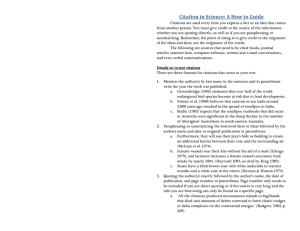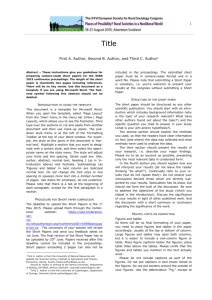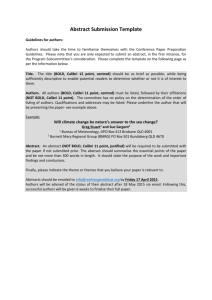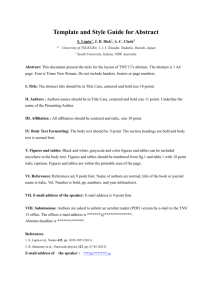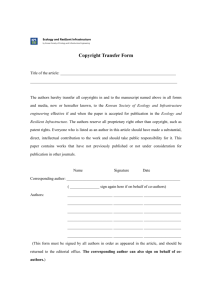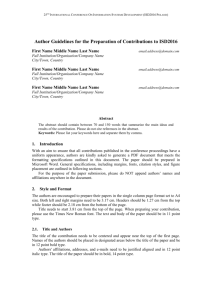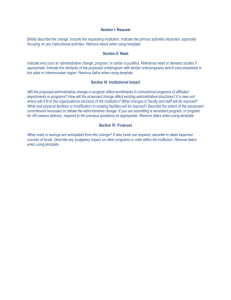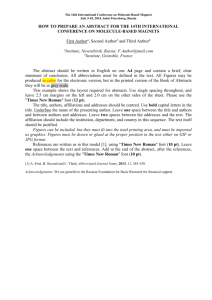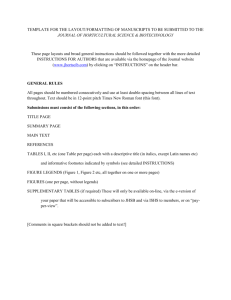Guide for Authors
advertisement
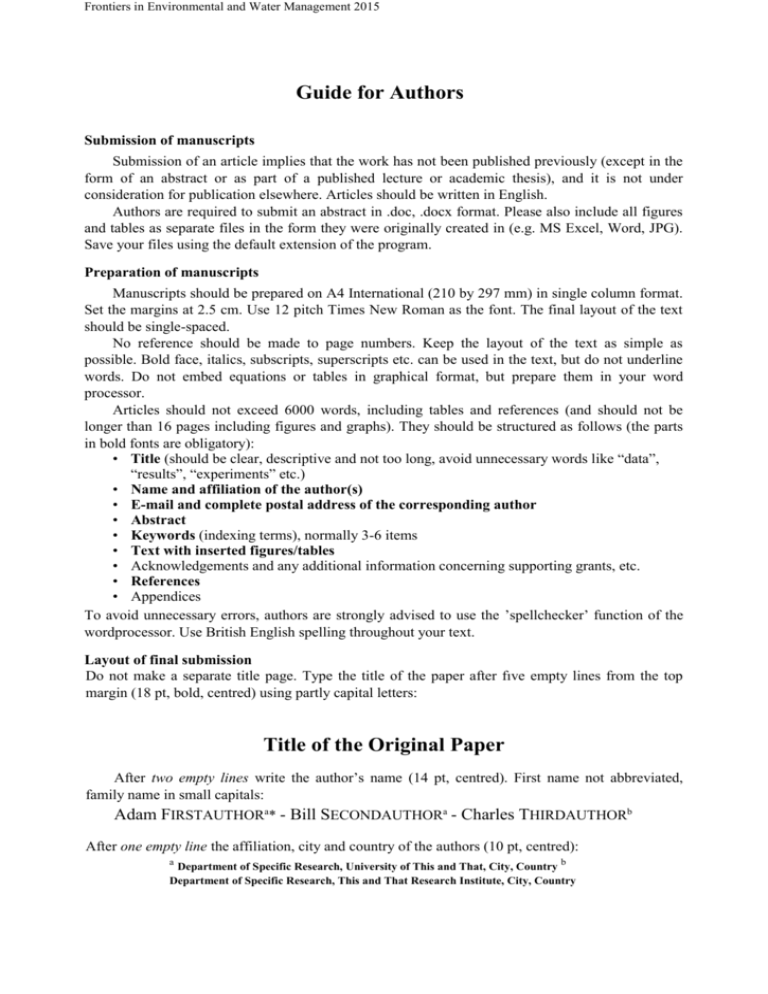
Frontiers in Environmental and Water Management 2015
Guide for Authors
Submission of manuscripts
Submission of an article implies that the work has not been published previously (except in the
form of an abstract or as part of a published lecture or academic thesis), and it is not under
consideration for publication elsewhere. Articles should be written in English.
Authors are required to submit an abstract in .doc, .docx format. Please also include all figures
and tables as separate files in the form they were originally created in (e.g. MS Excel, Word, JPG).
Save your files using the default extension of the program.
Preparation of manuscripts
Manuscripts should be prepared on A4 International (210 by 297 mm) in single column format.
Set the margins at 2.5 cm. Use 12 pitch Times New Roman as the font. The final layout of the text
should be single-spaced.
No reference should be made to page numbers. Keep the layout of the text as simple as
possible. Bold face, italics, subscripts, superscripts etc. can be used in the text, but do not underline
words. Do not embed equations or tables in graphical format, but prepare them in your word
processor.
Articles should not exceed 6000 words, including tables and references (and should not be
longer than 16 pages including figures and graphs). They should be structured as follows (the parts
in bold fonts are obligatory):
• Title (should be clear, descriptive and not too long, avoid unnecessary words like “data”,
“results”, “experiments” etc.)
• Name and affiliation of the author(s)
• E-mail and complete postal address of the corresponding author
• Abstract
• Keywords (indexing terms), normally 3-6 items
• Text with inserted figures/tables
• Acknowledgements and any additional information concerning supporting grants, etc.
• References
• Appendices
To avoid unnecessary errors, authors are strongly advised to use the ’spellchecker’ function of the
wordprocessor. Use British English spelling throughout your text.
Layout of final submission
Do not make a separate title page. Type the title of the paper after fıve empty lines from the top
margin (18 pt, bold, centred) using partly capital letters:
Title of the Original Paper
After two empty lines write the author’s name (14 pt, centred). First name not abbreviated,
family name in small capitals:
Adam FIRSTAUTHORa* - Bill SECONDAUTHORa - Charles THIRDAUTHORb
After one empty line the affiliation, city and country of the authors (10 pt, centred):
a
b
Department of Specific Research, University of This and That, City, Country
Department of Specific Research, This and That Research Institute, City, Country
Mark the corresponding author with an * and give his/her e-mail and complete postal address in
footnotes, 10 pt (* Corresponding author: account@domain.country; H-1118 BUDAPEST, Menesi ut 44.)
After three empty lines start the paper with an abstract.
Abstract
Page size
Margins:
A4, Top: 2.5 cm; bottom: 2.5 cm; left: 3.0 cm; right: 2.0 cm
Font:
Times New Roman
Line
spacing:
Title and text line spacing should be single line spacing
Title:
Centered, Times New Roman, 12 point, bold and begins with small letters except
special name. Taxonomic categories appear in italic. Title should be no more than
3 lines.
Author(s):
Centered, Times New Roman, 10 point, presenting author name and surname
should be underlined and it should be no more than 2 lines
Adress(es):
Centered, Times New Roman, italic, 8 point, different adresses should be clearly
indicated with superscripts (a, b, ...). and include e-mail address of
corresponding author.
Justify, in paragraph first line is 0 cm, before paragraph is 6 nk, after paragraph is
Abstract:
0 nk, line spacing is single line, Times New Roman, 10 point. There will be a
maximum of 5 keywords. Thanks (Acknowledge) "section is optional and should
not exceed three lines.
TEXT
1 FIRST GRADE TITLES (12 pt bold capitals) should be preceded by two and followed by one
empty line.
1.1 Second grade titles (12 pt bold) should be preceded by one empty line and followed by 6 pt.
1.1.1 Third grade titles (12 pt bold, italics) should be preceded by one empty line except when they
are right after a second grade title.
Paragraphs should be justified, the first line of a new paragraph should be indented 0.75 cm. Do not
separate paragraphs with one empty line or additional space.
Use italics for taxon names (Quercus robur) and for texts to be emphasized. Use single
quotation marks ('odd use') for a specific use of an otherwise well-known term, and apply double
quotation marks ("for citation") for citing text from other sources. Use italics for letter- abbreviated
mathematical, statistical parameters quoted in the test (A, h2)
Footnotes
Please do not use footnotes unless it is absolutely necessary. In most cases the information can be
incorporated in the text. If the use of footnotes is inevitable, please use Arabic numerals.
Citations in the text
In the text refer to the author’s name (without initial) and year of publication. Avoid excessive
citation of sources. If quoting a specific passage insert a short reference to the appropriate page(s). If
reference is made in the text to a publication written by more than two authors the name of the first
author should be used followed by “et al.” References cited together in the text should be arranged
chronologically. When quoting in the text, place the references in parentheses in the following
manner:
• Single authors: (Fekete 1999) or (Asimov 1984, p. 145)
• Two authors: (Schultz and Glasser 1986)
• Three or more authors: (Gugerli et al. 2001)
• A list of authors: (Hess 1952, Marton and Sparks 1967, Johnsson et al. 1998)
• For multiple papers in the same year : (Faraday 1977a,b)
• Within a sentence: Granier (1987) has stated ...
• Quoting a specific passage: „Empirical research confirms” (Smith 2003 pp. 23-24)
Tables
Authors should take notice of the limitation set by the size and layout of the proceedings. Tables
spread across double pages are difficult to read and to arrange. If many data are to be presented, an
attempt should be made to divide them to two or more tables. Reversing columns and rows will
often reduce the dimension of a table. Avoid the parallel presentation of the same data both in
figures and tables.
Tables should be numbered consecutively. The text should include references to all tables. The a
reference should appear in italics (Table 4).
Each table should have a brief and self-explanatory title. The number and title of the tables
should be printed in italics, before the table, left align.
Column headings should be brief, but sufficiently explanatory. Type table column headings with
an initial capital only. Standard abbreviations of units of measurement should be added between
parentheses. Vertical lines should not be used to separate columns.
Any explanation essential to the understanding of the table should be given as a footnote at the
bottom of the table, in 10 pitch characters.
Figures
When designing your figures, keep the size and the layout of the journal in mind. Colour figures
are not yet supported in the printed version. The figures should be drawn to allow reduction to
single column (7.5 cm) or double-column (15.5 cm) width. Use of very thin lines should therefore
be avoided. Black and white illustrations, if also available in electronic format, are accepted.
Figures should be numbered according to their sequence in the text, and they should all have
captions. The number and title of the figures should be printed in italics, below the figure, centred.
Refer to all figures (Figure 1) in the text by using italics and initial capitals.
Formulae
• Avoid possible confusion between 0 (zero) and o, O (letters); 1 (one) and I (letter); v
(Greek nu) and u, v (letters), etc.
• Mathematical symbols should appear in italics, p, and matrices and vectors in boldface, a,
B. Give the meaning of all symbols immediately after the equation in which they are first
used.
• For simple fractions use the solidus (/) instead of a horizontal line.
• Equations and formulae should be centered and numbered serially at the right-hand side in
parentheses if more than one is presented and quoted.
Acknowledgements
This paragraph should appear right before the References. The text should be as short as
possible. Heading (bold face) should be run within the text e.g.
Acknowledgements: We wish to thank ...
References
The reference section should contain all works referred to in the text, but no more. They should be
listed fully in alphabetical order of the author/editor with complete bibliographical details
(including publisher and place of publication). The list of references should be
arranged chronologically per author. If an author’s name in the list is also mentioned with coauthors, the following order should be used: publications of the single author, arranged according to
publication dates, publications of the same author with one co-author, publications of the author
with more than one co-author. Publications of the same author(s) in the same year should be listed as
1996a, 1996b, etc. The manuscript should be carefully checked to ensure that the spelling of author’
s names and dates are exactly the same in the text as in the reference list.
Use 11 pitch characters and 0.75 cm indentation from the second row on in a paragraph. Write
the family name of the authors with small capitals and only the initials of the first names. Put a
comma (,) after the family name when there are two or more authors. Write the year of the issue in
parenthesis behind the authors’ names and then use colon (:)
Note:
• Page references must be given for chapters in books and papers in journals.
• No italics except for taxa (Corvus corax) are used in the reference list.
• Use full name of less widely known journals (Applied Forestry), and abbreviate known
journals (J. Ecol.).
• Where possible avoid the use of ANON. and ANONYMOUS in the list of references.
Instead, use the publisher’s name.
• In the case of publications in any language other than English of German, the original title
should be retained, and the [translated title] should be given in cornered parenthesis.
A
notation such as “(in Swedish)” or “(in Hungarian with English abstract)” should be added
following the complete bibliographical details. However, the titles of publications in nonRoman alphabets (Russian, Japanese) should be transliterated. Transliteration should follow
English rules (e.g. xopomo = kharasho)
Reference should conform to the following examples:
For books:
Author, A. (1995): Book title. Publishing company, City. xx p.
Cody, M. L. (1974) :Competition and the structure of bird communities. Series: Monographs
in
Population Biology. Princeton Univ. Press. Princeton. 326 p.
For an article/chapter in a book
Author, D. (1984): Title of the article. In: Firsteditor, U. - Secondeditor V. (eds.): Title of the book.
Publishing company, City. x-xx.
Toppinen, A. - Adams, D. - Montgomery, D. (2001): Biodiversity conservation and forest products
in the United States Pacific Northwest. In: Palo, M. - Uusivuori, J. - Mery, G. (eds.): World
forests, Markets and Polices. Kluwer Academic Publishers, Dordrecht. 385-394.
For journal articles:
Author, B.C. (1977): Title of the paper. Journal Vol. (No) : x-xx.
Gray, A.N., Spies, T.A. (1997): Microsite controls on tree seedling establishment in conifer forest
canopy gaps. Ecology 78 (8): 2458-2473.
When the author is unknown:
Publisher (2003): Name of the publication. x-xx.
FAO (1993): Tropical Forest Resource Assessment 1990. Forestry paper No. 112. FAO, Rome,
Italy.
For work accepted for publication but not yet published:
Author, E. (in press): Title of the paper. Journal.
For publication in other languages:
Solymos, R. (2005): Erdö-es fagazdasâgunk idöszerü kerdesei. [Contemporary questions of forestry
and wood industry.] MTA, Budapest. 411 p. (in Hungarian)
For conference proceedings
Beall, F.C. (ed.) (2002): Proceedings of the 13th International Symposium on Nondestructive
Testing of Wood. Berkeley, CA. 335 p.
For a paper in conference proceedings
Pain, O., Boyer, E. (1996): A whole individual tree growth model for Norway spruce. In:
Proceedings of the second Workshop “Connection between Silviculture and Wood Quality
through Modelling Approaches and Simulation Software”. South Africa. August 1996. 1323.
For Internet sites:
Author (Date): Title of Web Page. Publisher with town and country, URL.
Inclusion of publisher with town and country makes the citation more durable, because
finding the reference does not depend entirely on the URL remaining correct.
FAO (2001): Forest resource assesment 2000. FAO, Rome, Italy.
Online: http: //www .fao.org/fore stry/fo/fra.
